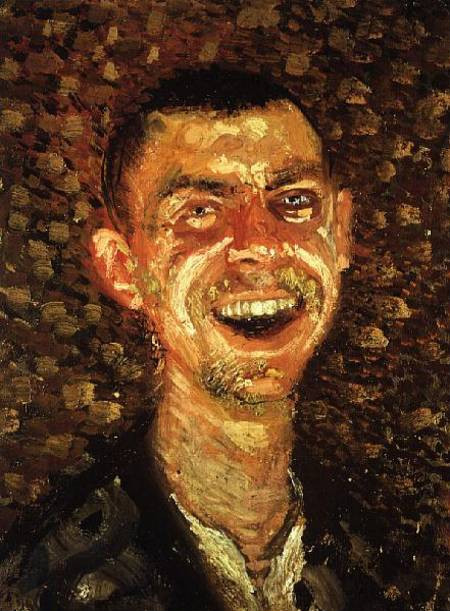It is all
about putting your best face forward. Photographer captures the fugitive moment
before it flees. Painter, like an envious sister of Photograher’s, constantly
resents the ephemeral existence of a mesmerising smile, which often freezes into
a stiff, twitchy line even before she applies onto the canvas a tentative
stroke. But one day as Painter is doing half-heartedly another portrait and
racking her brain trying to recall what ingenious sparks of spirit that just
seconds before flash across the sitter’s otherwise stoical face, her paintbrush
takes a sudden and willful sweep over the canvas, leaving a faint but
perceptible line on the person’s forehead. Disgruntled at first when Painter
sees what a careless mistake she has compounded with her clumsy toil, but then,
after assessing the screwed portrait at several different angles, a mischievous
smile plays upon her lips.
The sitter
remains the same throughout the process of painting but the authority belongs
to the painter, who holds the destiny of the sitter’s effigy firmly in his
hands. How joyful it is to paint an unappealing portrait of your nemesis!
Painter savours the inexpressive elation when one day she does a portrait of
her aloof sister, Photographer, on the sly and successfully renders her an unprepossessing
snob. In the end of the day Painter has a fitful night of sleep, incessantly disturbed
by her own uncontrollable laughter.
But it is
hardly a laughing matter when you are doing your own portrait. The experience often
leaves an uncanny effect, as though the painter was virtually creating his twin
sibling. You are staring into the mirror at yourself when doing the portrait
and afterward you will see your own creation staring back at you, solitary on a
canvas still devoid of a background. The photographer will most likely
associate the connection of the gazes, the painter’s and his creation’s, with some
sights that never fail to incite his curiosity- room within room, door opening
to yet another door, a maze of corridors promising no imminent exit. “I do not
doubt interiors have their interiors, and exteriors have their exteriors, and
that the eyesight has another eyesight,” so says Walt Whitman quite literally.
The
painter, Richard Gerstl, was one of the many Austrian artists whose portraits
are noted for their psychological insights and expressiveness. Psychology, like
sociology, is all about engagement. But rather of a more intimate engagement, psychology
plumps for a one-on-one conversation invariably conducted in a muted, wordless
manner. Therefore even when there is an expanding throng of viewers standing
before an Austrian painting, the figures in which deal with one at a time, broodingly
and patiently. Their gaze, instead of emitting shafts of blinding light that
intent on poking holes in the viewers’ eyes, breathe a cold air that envelopes
the little innocent crowd, like a lion appraising his wounded and writhing prey
from afar, before making the fatal spring.
The same
coldness permeates Richard Gerstl’s Self-Portrait
Laughing (1907), but a more expressive and menacing coldness, as the
painter is shown having a laugh, a mad and hearty laugh. The background is
composed by golden and brown daubs, as though the sky is ablaze with flying
flints. There are fires, too, burning in the painter’s eyes, but those flames do
not assume a confident ferocity. They are rather like the candles that intermittently
gutter, and spew out wax that moisten the eyes like tears that refuse to drop.
The smile
is certainly not victorious, nor does it seem to me glorious. If this is what
Gerstl reckoned as his “best face,” or at least, the face that he found the
most impressive, then he surely made no bones about his madness, or illness. But
by no means is the painter trying to elicit the viewers’ empathy and kindness
for his dismal situation. He is simply having his good, and possibly, last
laugh- at the fortune he is futile to change, at his unstable mentality he is
too disdained to seek any remedies, or at any unnamed enemies he is next bent
on destroying. The smile as all there is.

Comments
Post a Comment